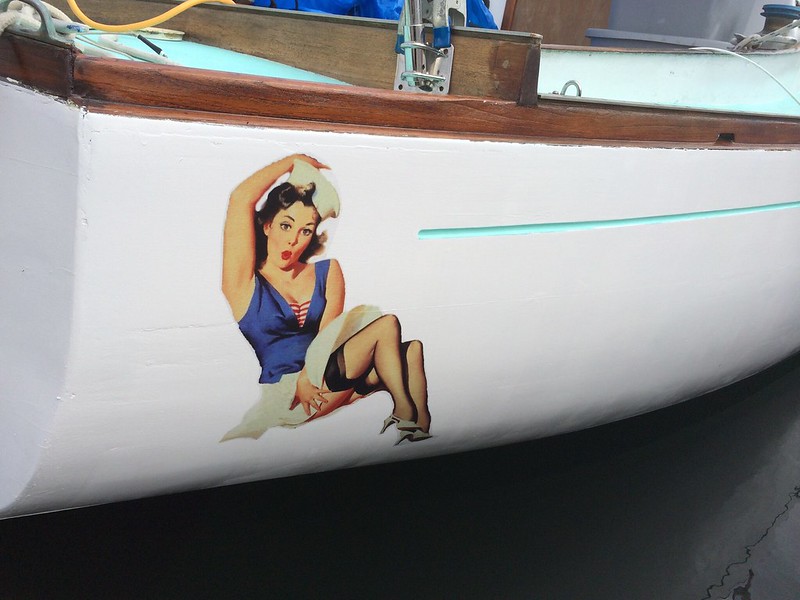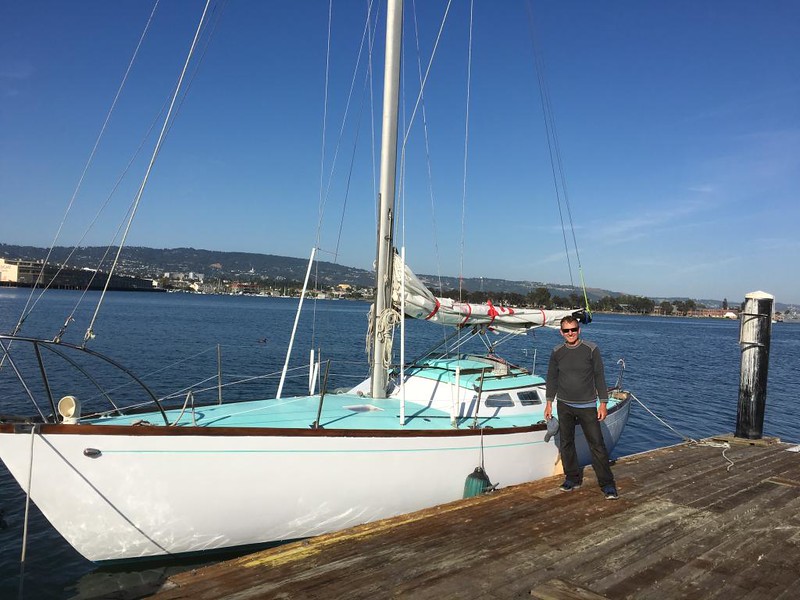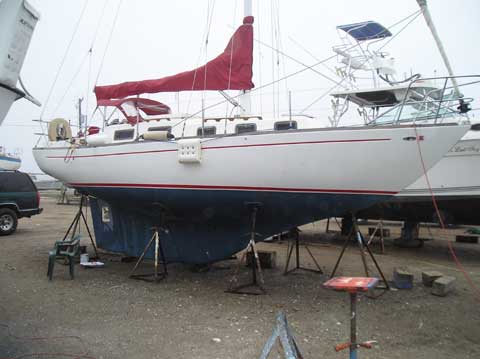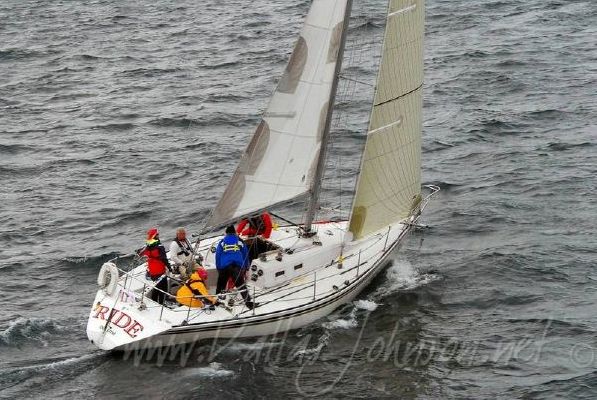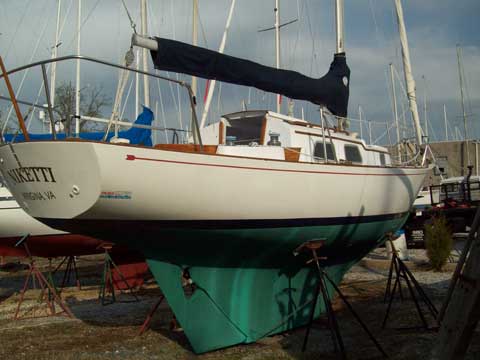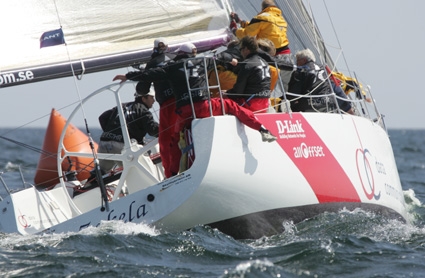Well, the earlier IOR boats were not so constrained/distorted by "The Rule".
Jackie... alphabet soup, here.
CCA = Cruising Club of America... This group was founded in the winter of 1921 by some avid yachtie-types and sort of modelled on the Royal Cruising Club of England. The notion was to incorporate racing as part of the overall "yachting" activity, and to create a prestigious association of yachts and owners. One of the things they did, starting in the late 1930's was develop a "rule"... a series of hull measurements which were taken and then analyzed to create a handicap rating for the boat in question. Whenever there's a "rule" there will be designers who will try to maximize a boat to perform under that rule. Since the CCA "rules" were somewhat "loose" and based on concepts of what made a good cruising boat back at that time, many, many boats from the 1940's and 50's and early 60's were designed to that rule. Most of Carl Albergs boats...the Pearson Triton, Ariel and Electra for example, were rated by the CCA rule.
As a very VERY general rule, boats that were designed with an eye to the CCA rule have what we would call today, "full keels", though maybe "full keel with cutaway forefoot" would be more accurate. They tend to have largish overhangs, fore and aft and they heel relatively quickly, to a point where stability really increases. They also heel to a point where the ends get in the water more and the functional waterline length goes up. Part of the idea was to limit wetted surface when not heeled.....in light air.... and then stretch the boat out in heavier air.
Here's an Alberg 29, a redesign of the classic Alberg 30, showing a typical CCA-type underbody.
Nowadays, folks tend to think of CCA-rule-type boats as slower but they definitely make good cruising boats....though maybe on the wet side. A few well-known CCA deisgners were C. Raymond Hunt, Carl Alberg, the early Sparkman and Stevens office, and Halsey Herreschoff. Charley Morgan did more than a few CCA-type boats.
IOR - International Offshore Rule...The IOR evolved from the Cruising Club of America (CCA) rule for racer/cruisers and the Royal Ocean Racing Club (RORC) rule. It was based on a series of hull and rig measurements, and a stability test. Those numbers were plugged into a super-secret formula...which by about 1975 every designer worth a nickel had figured out, and that formula generated a handicap. That handicap was expressed as a theoretical boat length. So it was that a typical IOR "One-tonner" (which didn't weigh a ton, the "ton" language actually refers to an old trophy that was given out, early in the history of the class) had a rating around 30 and was probably something like about 36-40 feet LOA. Well, not everybody wants to race a 40-footer and so as time went on, what was called "level-rating-classes" were developed. Two-tonners were 50-footers, more or less. One-tonners were 40 footers, plus or minus. Half-tonners were 28-30 footers. Quarter-tonners were 24-27 footers. Mini tonners were 20-21 footers. To very much oversimplify, the LOA of the level rating classes increased over the years. So for example, the Wylie Hawkfarm was a mid-early half-tonner, with a LOA of about 28 feet. it would compete straight-ahead with the Ron Holland designed Silver Shamrock of 1972, which is 29.9 feet LOA....and so on.
The super-secret formula wasn't perfect, as these things never are. So as designers started figuring out what the formula was, they started designing boats which maximized performance under the handicap which the rule created. This tended to develop boats which were very small in the hindquarters, often had a lot of tumblehome, had minimal ballast and very complicated rigs. Rigs tended to have very small mainsails and large foretriangles. This mean that you had to have a huge array of headsails for varying conditions and you had to develop a foredeck crew that was absolutely expert at doing headsail changes. As a very general guideline, "early"...meaning late 1960's and early 1970's IOR boats tended to be less extreme in terms of the hull distortion imposed by the rule. By the time we got into the early-mid 1980's (when I started sailing), an awful lot of IOR boats were just wicked machines to handle in a breeze. They were fast upwind, required huge crews overall, and were terribly unstable off the wind in a breeze. In the smaller classes, it became fairly obvious in time that having ballast really high in the boat was a rating advantage, and so for a couple of years there were actually IOR quarter tonners built with NO outside ballast...just a daggerboard with enough weight in it to make it sink. All the lead was INSIDE the boat. In fact, one of those boats, with most of the internal ballast taken out and a new modern keel bolted on, is still racing quite happily out of the Alameda Marina. It's been revived and painted sparkle-bronze and if I could remember the boat/owners name, I'd write it here.
a WHOLE lot of 1970's production boats in the 22-28 foot range were rated as quarter tonners or half-tonners without *really* being designed as such. Jackie, you sail a Cal 2-27. Perhaps you're aware of the original Cal 27, which exists in a version called the Cal T-2 27. The T-2 is just a Cal 27 with rigging and deck modifications which enable it to "measure in" as a half-tonner. The hard-chine Thunderbird is, technically, a quarter-tonner. So is the Ranger 23, the Sprinta Sport (which really looks like one), the Santana 25 (not the 525), Carl Schumachers "Summertime Dream". There was a company on the SF Peninsula, "Sudden Yachts" that cranked out about a dozen Gary Mull quarter-tonners.
Here's a Ron-Holland IOR boat.
This is one of the Gary Mull quarter tonners (still in the Bay Area) made by Sudden Yachts
Some well known IOR designers were Ron Holland, Doug Peterson, Laurie Davidson and Bruce Farr, with locals Gary Mull, Tom Wylie, the Nelson-Marek team and Carl Schumacher making their marks, too. If you would like to see a very typical IOR-type hull, find a Cal 9.2 from the late 1970's/early 1980's. That design originally won the IOR Half-ton worlds and then Cal built a mold from the hull to sell as a racer-cruiser. Find a Nelson-Marek 36 from the very early 80's...that's the same thing.
Upshot was, by the early 1980's an awful lot of IOR-designed boats really were not that good-sailing boats. They "rated well" but were miserable to sail. I would like to point out that not ALL IOR-influenced boats were pigs, eh? The Hawkfarm is eminently NOT a pig, it's a very good ocean boat. Rob MacFarlane is out cruising shorthanded on a Nelson-Marek 45, which is an IOR design. The array of production boats which theoretically rate as a quarter-tonner is quite long...

